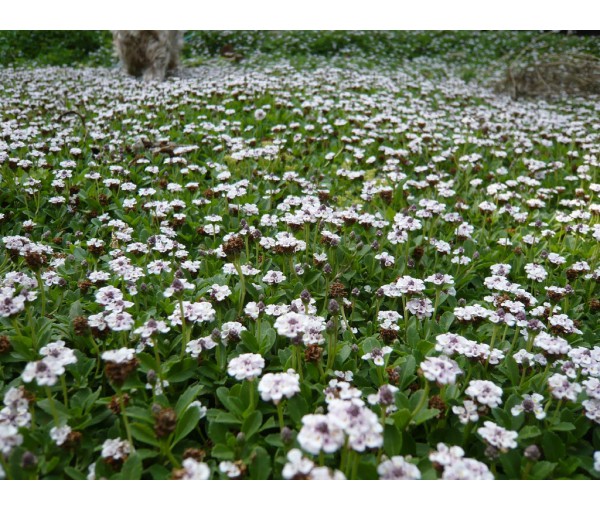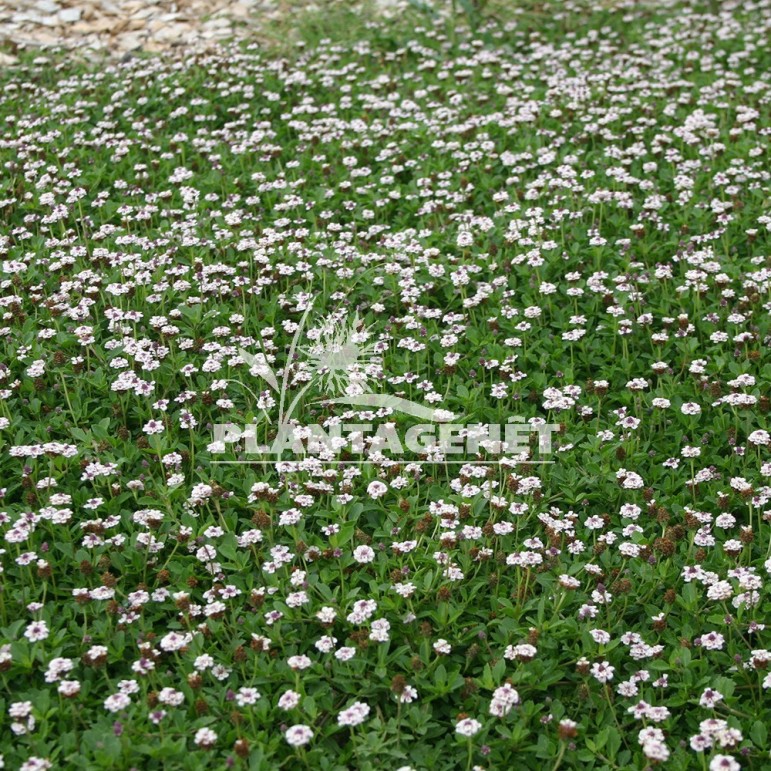Pin su Green words medows + ground covers

Lippia Repens Phyla Nodiflora) lupon.gov.ph
Phyla nodiflora Description Download Save Share Common lippia, also known as frogfruit, is a low growing perennial that spreads over the ground with long linear stems to form a dense carpet-type planting. When grown as an unmowed bank plant, it can reach heights of 5-6 inches and have a soft cushion-like habit.

Lippia nodiflora (Lippia) the online Flora of the Maltese Islands.
Lippia nodiflora is a perennial herbaceous plant, also known as Bella carpet or simply Lipia, belongs to the verbenaceae family, is characterized by its small size and rapid growth, being a cover plant, it is good to replace conventional grass Some animals even use it as a nutrient source for their diet, in addition to being an excellent source of nectar for butterflies.

Lippia Nodiflora (Phyla Nodiflora) Lipia Bf40 Jardi Jaroa S.L.
Taxonomic notes. Synonyms: Lippia nodiflora (Linnaeus) Michaux. Varieties: Phyla nodiflora (Linnaeus) Greene var. minor (Hooker) O'Leary and Mulgara; Phyla nodiflora (Linnaeus) Greene var. nodiflora. Description "Appressed pubescent, prostate to ascending or decumbent, perennial herbs, rooting at the nodes, obscurely to definitely 4- angled.

Lippia repens (syn. Phyla nodiflora) Buy Online at Annie's Annuals
Lipia is a plant that it barely lifts 10 centimeters from the ground, However, as it develops while rapidly covering the ground, its extended stems can reach between 30 and 90 centimeters. It has small oval green leaves and a serrated edge.

Pin su Giardino secco Dry garden
The Lippia nodiflora is a perennial herb, also known as Bella carpet or just Lipia. It belongs to the Verbenaceae family, it is characterized by its small size and rapid growth.Because it is a covering plant it is great to replace the classic lawn. Some animals even use it as a source of nutrients for their food, as well as being an excellent source of nectar for butterflies.

Lippia nodiflora Yerba de la Sainte Maria, TeppichVerbene Häußermann Stauden und Gehölze
196,99 € Votre magasin tous les cours en magasin Caractéristiques principales Lot de 45 Verveine nodiflore en godet pour une surface de 5m² La Verveine nodiflore est une variété de vivace couvre-sol idéal comme alternative au gazon. Elle supporte le piétinement, est sans entretien (pas besoin de tondre) et facile de culture.

Lippia nodiflora, Phyla nodiflora, Verveine nodiflore Pépinière l'Arc en Fleurs
Kurapia grass was developed in Japan by Dr. H. Kuramochi and is breaded from the lippie nodflora. It is unable to produce seed compared with other types of grass species. This kurapia grass is not as invasive either and is a live flowering plant that grows low and dense. This grass is easy to grow and quite drought tolerant.

LIPPIA nodiflora o repens sin. PHYLA Vivaio Noaro
Feet, paws and fire proof! This carefree native of CA and beyond is probably one of the best lawn substitutes - especially for difficult areas where nothing will grow! Highly adaptive to most soils: wet, dry, even clay. Plant 2' apart for a quick, dense, creeping turf only 2" tall or use it for erosion control.

Lippia repens (syn. Phyla nodiflora) Buy Online at Annie's Annuals
Lippia is a genus of flowering plants in the verbena family, Verbenaceae. It was named after Augustus Lippi, (1678-1705), a French naturalist and botanist (with Italian origins). He was killed in Abyssinia. The genus contains roughly 200 species of tropical shrubs that are found around the world.

LIPPIA nodiflora / Phyla ou Verveine nodiflore
Lippia ground cover now known as frog fruit, turkey tangler, or its scientific name Phlya Nodiflora is a perennial ground cover that provides superior drought resistance when compared to grass lawns. Originally Phyla Nodiflora or lippia ground cover was most popular around 1925 when grass was still new to America as a lawn.

Lippia repens (syn. Phyla nodiflora) Buy Online at Annie's Annuals
Blog Lippia nodiflora: how to grow it A small creeping plant forming beautiful green carpets without the need for constant watering, Lippia nodiflora is ideal for replacing lawns in Mediterranean regions where its foliage remains evergreen. A maintenance-free ground cover plant

Lippia repens (syn. Phyla nodiflora) Buy Online at Annie's Annuals
Lippia ( Phyla nodiflora) is an ornamental plant in the Verbenaceae family, which is native from Brazil and United States. It can be found in tropical areas around the globe, a naturalized species in many places. This plant is cited in "Flora Brasiliensis" by Carl Friedrich Philipp von Martius. Lippia is a flowering, broadleaf plant.

Lippia nodiflora (Lippia) the online Flora of the Maltese Islands.
Lippia Frog Fruit Turkey Tangle Botanic Name Genus: Phyla Species: nodiflora Variety: Type: Annual/Perennial Family: VERBENACEAE Origins: Southern USA Light: Full Sun to Part Shade Wind: Medium Growth: Fast Frost: Tender Evergreen: Yes Native: No Height: 0.1 m Width: 0 m Position Groundcover RETAIL Availability Easy to find Flower Colour Mauve

Plantas y flores Lippia nodiflora
Matchweed is a mat-forming broadleaf weed with hairy, lateral stems that are freely branched and rooting at the nodes. Its leaves grow opposite and feature small teeth at the outer tip. Blooming from May through October, Matchweed features flowers that are rose-purple or white in color. They form in a head at the tip of a long stalk, resembling.

Lippianodiflora (Plante couvre sol "carpet" à petite fleurs blanches résistante à la sécheresse
Frog fruit ( Lippia nodiflora syn. Phyla nodiflora) is also called turkey tangle frog fruit. What is frog fruit? It is a native plant of North America and in the Verbena family of flowering herbaceous plants. Frog fruit plants are low growing plants that develop only about 3 to 5 inches (7.5 to 13 cm.) in height.

Lippia nodiflora (Lippia) the online Flora of the Maltese Islands.
a creeping perennial herb rooting at the nodes, obscurely pubescent, with closely adpressed silvery-white canoe-shaped unicellular hairs attached by the middle, acuminate and serrulate at both ends; stem ridged, with internodes 1 1/2-3 in. long; leaves opposite, sessile or petiolate, obovate, cuneate and entire in the basal half, sharply and coarsely dentate towards the rounded or subacute.